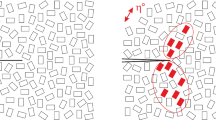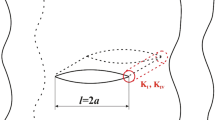Abstract
Experimental results indicate three regimes for cracking in a ferroelectric double cantilever beam (DCB) under combined electromechanical loading. In the loading, the maximum amplitude of the applied electric field reaches almost twice the coercive field of ferroelectrics. Thus, the model of small scale domain switching is not applicable any more, which is dictated only by the singular term of the crack tip field. In the DCB test, a large or global scale domain switching takes place instead, which is driven jointly by both the singular and non-singular terms of the crack-tip electric field. Combining a full field solution with an energy based switching criterion, we obtain the switching zone by the large scale model around the tip of a stationary impermeable crack. It is observed that the switching zone by the large scale model is significantly different from that by the small scale model. According to the large scale switching zone, the switch-induced stress intensity factor (SIF) and the transverse stress (T-stress) are evaluated numerically. Via the SIF and T-stress induced by the combined loading and corresponding criteria, we address the crack initiation and crack growth stability simultaneously. The two theoretical predictions roughly coincide with the experimental observations.
Similar content being viewed by others
References
Cao H C, Evans A G. Electric-field-induced fatigue crack growth in piezoelectrics. J Am Ceram Soc, 1994, 77: 1783–1786
Park S, Sun C T. Fracture criteria for piezoelectric ceramics. J Am Ceram Soc, 1995, 78: 1475–1480
Lynch C S, Yang W, Collier L, et al. Electric field induced cracking in ferroelectric ceramics. Ferroelectrics, 1995, 166: 11–30
Wang H, Singh R N. Crack propagation in piezoelectric ceramics: effects of applied electric field. J Appl Phys, 1997, 81: 7471–7479
Weitzing H, Schneider G A, Steffens J, et al. Cyclic fatigue due to electric loading in ferroelectric ceramics. J Eur Ceram Soc, 1999, 19: 1333–1337
Zhu T, Fang F, Yang W. Fatigue crack growth in ferroelectric ceramics below the coercive field. J Mater Sci Lett, 1999, 18: 1025–1027
Fu R, Zhang T Y. Effects of an electric field on the fracture toughness of poled lead zirconate titanate ceramics. J Am Ceram Soc, 2000, 83: 1215–1218
Fang D N, Liu B, Sun C T. Fatigue crack growth in ferroelectric ceramics driven by alternating electric fields. J Am Ceram Soc, 2004, 87: 840–846
Jelitto H, Kessler H, Schneider G A, et al. Fracture behavior of poled piezoelectric PZT under mechanical and electrical loads. J Eur Ceram Soc, 2005, 25: 749–757
Shieh J, Huber J E, Fleck N A. Fatigue crack growth in ferroelectrics under electrical loading. J Eur Ceram Soc, 2006, 26: 95–109
Narita F, Shindo Y, Saito F. Cyclic fatigue crack growth in three-point bending PZT ceramics under electromechanical loading. J Am Ceram Soc, 2007, 90: 2517–2524
Westram I, Lupascu D, Rödel J, et al. Electric-field-induced crack initiation from a notch in a ferroelectric ceramic. J Am Ceram Soc, 2007, 90: 2849–2854
Fang F, Yang W, Zhang F C, et al. Electric field-induced crack growth and domain-structure evolution for [100]- and [101]-oriented 72Mg1/3Nb2/3)O-3-28 ferroelectric single crystals. J Mater Res, 2008, 23: 3387–3395
Pojprapai S, Russell J, Man H, et al. Frequency effects on fatigue crack growth and crack tip domain-switching behavior in a lead zirconate titanate ceramic. Acta Mater, 2009, 57: 3932–3940
Yang W. Mechatronic Reliability. Berlin: Tsinghua University Press and Springer-Verlag, 2002
Schneider G A. Influence of electric field and mechanical stresses on the fracture of ferroelectrics. Annu Rev Mater Res, 2007, 37: 491–538
Lu W, Fang D N, Li C Q, et al. Nonlinear electric-mechanical behavior and micromechanics modeling of ferroelectric domain evolution. Acta Mater, 1999, 47: 2913–2926
Huber J E, Fleck N A. Multi-axial electrical switching of a ferroelectric: theory versus experiment. J Mech Phys Solids, 2001, 49: 785–811
Kamlah M. Ferroelectric and ferroelastic piezoceramics — modeling of electromechanical hysteresis phenomena. Continuum Mech Thermodyn, 2001, 13: 219–268
Shieh J, Huber J E, Fleck N A. An evaluation of switching criteria for ferroelectrics under stress and electric field. Acta Mater, 2003, 51: 6123–6137
Landis C M. On the fracture toughness anisotropy of mechanically poled ferroelectric ceramics. Int J Fract, 2004, 126: 1–16
Zhang W, Bhattacharya K. A computational model of ferroelectric domains. Part I: Model formulation and domain switching. Acta Mater, 2005, 53: 185–198
Li Y C. Nonlinear constitutive law for ferroelectric/ferroelastic material and its finite element realization. Sci China Ser G-Phys Mech Astron, 2007, 50: 70–86
Li H J, Liu F, Wang T C. Nonlinear constitutive behavior of ferroelectric materials. Sci China Ser G-Phys Mech Astron, 2008, 51: 1339–1356
Hwang S C, Lynch C S, McMeeking R M. Ferroelectric/ferroelastic interactions and a polarization switching model. Acta Metall Mater, 1995, 43: 2073–2084
Zhu T, Yang W. Toughness variation of ferroelectrics by polarization switch under nonuniform electric field. Acta Mater, 1997, 41: 4695–4702
Reece M J, Guiu F. Toughening produced by crack-tip-stress-induced domain reorientation in ferroelectric and/or ferroelastic materials. Philos Mag A, 2002, 82: 29–38
Kalyanam S, Sun C T. Modeling the fracture behavior of piezoelectric materials using a gradual polarization switching model. Mech Mater, 2009, 41: 520–534
McMeeking R M, Evans A G. Mechanics of transformation-toughening in brittle materials. J Am Ceram Soc, 1982, 65: 242–246
Yang W, Zhu T. Switch-toughening of ferroelectrics subjected to electric fields. J Mech Phys Solids, 1998, 46: 291–311
Zhu T, Yang W. Fatigue crack growth in ferroelectrics driven by cyclic electric loading. J Mech Phys Solids, 1999, 47: 81–97
Fang F, Yang W. Poling enhanced fracture resistance of lead zirconate titanate ferroelectric ceramics. Mater Lett, 2000, 46: 131–135
Zeng X, Rajapakse R. Domain switching induced fracture toughness variation in ferroelectrics. Smart Mater Struct, 2001, 10: 203–211
Beom H G, Atluri S N. Effect of electric fields on fracture behavior of ferroelectric ceramics. J Mech Phys Solids, 2003, 51: 1107–1125
Ricoeur A, Kuna M. A micromechanical model for the fracture process zone in ferroelectrics. Comput Mater Sci, 2003, 27: 235–249
Mao G Z, Fang D N. Fatigue crack growth induced by domain switching under electromechanical load in ferroelectrics. Theor Appl Fract Mech, 2004, 41: 115–123
Kuna M. Fracture mechanics of piezoelectric materials-where are we right now? Eng Fract Mech, 2010, 77: 309–326
Westram I, Ricoeur A, Emrich A, et al. Fatigue crack growth law for ferroelectrics under cyclic electrical and combined electromechanical loading. J Eur Ceram Soc, 2007, 27: 2485–2494
Kanninen M F. An augmented double cantilever beam model for studying crack propagation and arrest. Int J Fract, 1973, 9: 83–92
Murakami Y (ed.). Stress Intensity Factors Handbook. Oxford: Pergamon Press, 1987
Yang W, Suo Z. Cracking in ceramics actuators caused by electrostriction. J Mech Phys Solids, 1994, 42: 649–663
Cui Y Q, Zhong Z. Large scale domain switching around the tip of an impermeable stationary crack in ferroelectric ceramics driven by near-coercive electric field. Sci China Phys Mech Astron, 2011, 54: 121–126
Tada H, Paris P C, Irwin G R. The Stress Analysis of Cracks Handbook. St. Louis: Del Research Corporation, 1973
Williams M L. On stress distribution at the base of a stationary crack. J. Appl Mech-Trans ASME, 1957, 24: 109–114
Cotterell B, Rice J R. Slightly curved or kinked cracks. Int J Fract, 1980, 16: 155–169
Leevers P S, Radon J C. Inherent stress biaxiality in various fracture specimen geometries. Int J Fract, 1982, 9: 311–325
Sherry A H, France C C, Goldthorpe M R. Compendium of T-stress solutions for two and three dimensional cracked geometries. Fatigue Fract Eng Mater Struct, 1995, 18: 141–155
Cui Y Q. Interplay between fracture and domain switching of ferroelectrics. Dissertation for the Doctoral Degree. Beijing: Tsinghua University, 2005
Fett T. Compendium of T-stress solutions. Technik und Umwelt Wissenschaftliche Berichte, FZKA 6057, 1998
Sham T L. The determination of the elastic T-term using higher order weight functions. Int J Fract, 1991, 48: 81–102
Zhou D Y. Experimental investigation of non-linear constitutive behavior of PZT piezoceramics. Dissertation for the Doctoral Degree, Karlsruhe: Karlsruhe University, 2003.
Hackemann S, Pfeiffer W. Domain switching in process zones of PZT: Characterization by microdiffraction and fracture mechanical methods. J Eur Ceram Soc, 2003, 23: 141–151
Author information
Authors and Affiliations
Corresponding author
Additional information
Contributed by YANG Wei
Rights and permissions
About this article
Cite this article
Cui, Y., Yang, W. Electromechanical cracking in ferroelectrics driven by large scale domain switching. Sci. China Phys. Mech. Astron. 54, 957–965 (2011). https://doi.org/10.1007/s11433-011-4308-y
Received:
Accepted:
Published:
Issue Date:
DOI: https://doi.org/10.1007/s11433-011-4308-y




